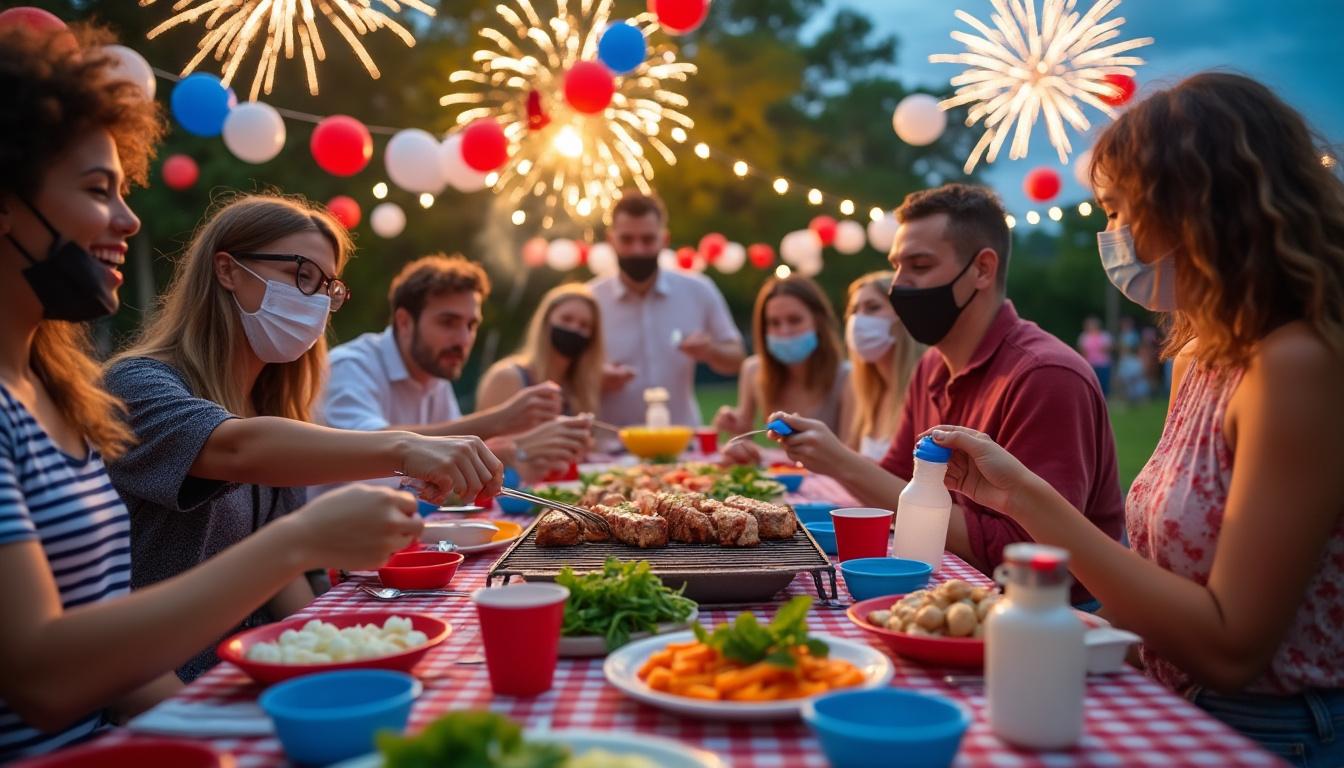Independence Day safety tips to prevent foodborne illness at July 4th cookouts. Expert grilling, storage and hygiene guidance for a safe, delicious holiday celebration.
Embrace a safer Independence Day by prioritizing clean handling, correct temperatures and responsible grilling. Crowds, heat and outdoor kitchens increase the risk of foodborne illness, but simple precautions keep gatherings joyful. This guide highlights practical steps for hosts, vendors and families to protect guests while serving patriotic menus that celebrate freedom—without the emergency room visit.
Independence Day Food Safety Checklist For Cookouts
Hosts planning July 4th gatherings should treat food safety as part of the event checklist. A clear plan reduces bacterial transfer, avoids cross-contamination and keeps perishable items out of the danger zone.
- Prepare a timeline: plan fridge space, thawing and cooking windows to avoid leaving food at ambient temperature.
- Assign roles: designate one person to monitor grill temperatures and another to handle salads and desserts.
- Use trusted brands: integrate GrillSafe thermometers and label coolers for raw versus cooked items to stay RedWhiteAndClean.
Essential steps to reduce foodborne illness risks
Thawing, cooking and storage are the three critical moments when bacteria grow or die. Controlled handling mitigates risk and supports a smooth celebration.
- Thaw safely: plan refrigeration thawing or cold-water methods rather than leaving meat out.
- Cook thoroughly: reach safe internal temperatures verified with a GrillSafe thermometer.
- Chill promptly: refrigerate leftovers within two hours, or one hour if temperatures exceed 90°F.
| Item | Safe Action | Why It Matters |
|---|---|---|
| Raw poultry | Separate, cook to 165°F | Kills Salmonella and Campylobacter |
| Leftovers | Refrigerate in shallow containers within 2 hours | Prevents bacterial growth |
| Salads & sides | Keep chilled on ice and out of direct sun | Reduces risk for starchy or mayo-based dishes |
For step-by-step grilling checks, hosts can review practical tips on safe meat handling at how to grill chicken and steak safely. Planning and simple tools make Independence Day safer and more enjoyable.
Independence Day Grilling: Safe Practices for July 4th
Grill-focused celebrations are central to Independence Day traditions. Proper grill maintenance and cooking practice protect guests and support a memorable StarSpangledGrill feast.
- Inspect equipment: check grills for leaks, residue and stability before lighting.
- Monitor heat: use a thermometer; avoid guessing cook times by eye alone.
- Keep raw separate: never place cooked food on plates that held raw meat.
Practical grilling scenarios and solutions
Real-world examples help hosts adapt. A community organization, PatriotGuard Foods, once prevented a mass illness by assigning one volunteer as temperature monitor, using dedicated tongs and a labeled prep area.
That simple change reduced cross-contamination and kept the event on schedule.
| Scenario | Safe Response | Tools |
|---|---|---|
| Busy public BBQ | Set up separate serving and prep stations | Plastic barriers, labeled bins, thermometers |
| Picnic potluck | Encourage chilled transport and ice packs | Coolers, insulated bags |
| Multiple grills | Assign one grill for vegetables to avoid meat juices | Color-coded tools |
Additional recipes and safe serving ideas can be borrowed from reputable sources such as Ina Garten’s crowd-pleasing dinners (Ina Garten dinner recipe) while maintaining strict hygiene and temperature control.
Hosts who adopt FreedomFeast standards—clear roles, labeled tools and constant temperature checks—reduce risk and allow guests to savor the holiday safely.
Independence Day Family Protection: Prevent Foodborne Illness at Parties
Protecting children, older adults and immunocompromised guests must be a priority on Independence Day. These groups face higher risk from common pathogens during outdoor gatherings.
- Designate cool zones: keep perishable foods in shaded, ice-filled containers labeled for quick access.
- Educate helpers: brief volunteers on handwashing and cross-contamination avoidance.
- Prepare safe kid-friendly plates: offer fully cooked, cooled items and avoid high-risk foods for young children.
Community examples, resources and outreach
Local libraries and community gardens often host prep workshops that teach families how to pack safe picnics; these outreach efforts reduce incidents and build resilience.
For families seeking seasonal projects, nurturing a garden can teach children about food safety from seed to plate—resources available at children gardening passion and practical tips at children gardening tips.
| Audience | Protective Measure | Benefit |
|---|---|---|
| Children | Offer pasteurized dairy and fully cooked proteins | Reduces exposure to Listeria and Salmonella |
| Older adults | Avoid raw or undercooked dishes; keep food hot above 140°F | Prevents bacterial growth and severe illness |
| Large crowds | Stagger serving times and replenish small batches | Maintains freshness and reduces contamination |
Community vendors can brand their stands with PatriotGuard Foods or SafeStars BBQ to signal adherence to safety standards, while hosts adopt LibertyPlates and FreshFourth practices for visible reassurance.
For broader summer safety, including heat management and energy-saving cooling tips that support food safety, consult advice such as ways to save energy and stay cool. Small operational choices keep Independence Day celebrations both festive and safe.
Event organizers who brand their safety plan as SafeFest or promote a IndependenceSafe pledge create trust and reduce last-minute risks for guests.
Additional references and community resources
- Practical food safety guidance: food safety for the 4th of July
- Children’s garden projects to teach food origins: children gardening tips part 2
- Household financial prep for summer events: tax deductions for parents and budgeting strategies like the debt snowball method
Adopting clear visual cues, training volunteers and keeping food at safe temperatures transforms a traditional picnic into a confident, health-conscious celebration. Final insight: visible safety practices increase guest comfort and reduce incidents—ensuring memories, not illnesses.
Q: How long can prepared food sit out during Independence Day gatherings?
A: Perishable food should not sit out more than two hours; if temperatures exceed 90°F, reduce that to one hour. Use shallow containers and coolers to maintain safe temperatures.
Q: What is the minimum internal temperature for safely cooked poultry at a July 4th barbecue?
A: Poultry should reach an internal temperature of 165°F measured with a reliable GrillSafe thermometer. Checking multiple spots ensures thorough cooking.
Q: Are store-bought salads safe for outdoor parties?
A: Yes if kept chilled below 40°F until serving. For longer events, place salads on ice and limit time at room temperature to reduce bacterial growth.
Q: How can hosts prevent cross-contamination during busy cookouts?
A: Use separate cutting boards, color-coded utensils, and dedicated plates for raw and cooked items. Label containers clearly and rotate tools to avoid accidental reuse.
Q: Where can community organizers learn more about safe event practices for Independence Day?
A: Local public health pages and community programs often post checklists; additional practical examples are available through linked resources above, including grilling guides and children’s gardening programs to teach long-term food safety habits.

